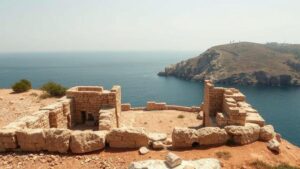Searching for the truth behind the “Crystal Skulls,” said to be artifacts of an advanced ancient civilization.
Searching for the Truth Behind the Crystal Skulls
The enigmatic Crystal Skulls have long captivated the imagination of archaeologists, historians, and the general public alike. Said to be artifacts from an advanced ancient civilization, these skulls have sparked debates about their origins, purposes, and the myths surrounding them. This article dives into the discovery and history of the crystal skulls, analyzing their authenticity and cultural significance.
The Origins of the Crystal Skulls
The most famous of the crystal skulls is the one known as the Mitchell-Hedges Skull, which was purportedly discovered in 1924 by F.A. Mitchell-Hedges in Belize. Local legend states that it was found during an expedition to the Mayan ruins of Lubaantun. This particular skull is made of clear quartz and is remarkable for both its craftsmanship and the legends surrounding it. It is said to possess mystical powers, contributing to its aura of mystery.
Also to the Mitchell-Hedges Skull, other notable crystal skulls include:
- The Smithsonain Skull, which is housed in the Smithsonian Institution.
- The Paris Skull, part of a private collection and displayed at the Musée du quai Branly.
Materials and Craftsmanship
Most of the crystal skulls are carved from quartz crystal, known for its beauty and clarity. The crafting techniques used are particularly intriguing; while modern tools can easily replicate such objects, the technology available to ancient civilizations raises questions about their origins. For example, the Mitchell-Hedges Skull has been analyzed using modern technology, revealing that it took an estimated 300-500 hours of labor to create, suggesting advanced craftsmanship.
Also, the tools that would have been required to produce such intricate designs are not conclusively identified within the known context of ancient civilizations. This has led some researchers to assert that the skulls could not have been created by the ancient Maya or other contemporary cultures of the time.
Scientific Examination
Scientific scrutiny of the crystal skulls indicates they are not as ancient as claimed. For example, studies have shown that the crystals used in the skulls are consistent with modern sourcing techniques, suggesting the skulls might have originated from the late 19th or early 20th century rather than from an ancient civilization. Curator Hertzog in a 1992 study noted that the technology to achieve such precision with crystal would exceed that of the era purportedly responsible for their creation.
Cultural Significance and Impact
Regardless of their origins, the crystal skulls have had a significant cultural impact. have become icons in popular culture, influencing literature, art, and film. The most notable reference is found in the film Indiana Jones and the Kingdom of the Crystal Skull, which has further fueled the mystery and allure surrounding these artifacts.
Plus, many people ascribe metaphysical properties to the skulls, believing they hold powers of healing or enhanced intuition, leading to interest in crystal therapy and New Age practices.
Controversies and Skepticism
Despite the captivating tales and cultural significance, skepticism abounds regarding the authenticity of the skulls. Critics, such as archaeologist Christopher J. Dunn, argue that the claims surrounding the skulls often have little to no scientific backing, emphasizing that many so-called ancient artifacts are the product of modern fabrication. Also, claims regarding lost civilizations and advanced technological achievements often lack credible evidence.
Conclusion: The Enduring Mystery
The truth about the crystal skulls remains elusive. While scientific analyses suggest they are not ancient artifacts, their fascinating history and the lore surrounding them continue to spark interest and debate. Whether objects of intrigue, potential frauds, or the remnants of an undiscovered advanced civilization, they remain a testament to humanitys quest for understanding the past.
In summary, exploring the mystery of crystal skulls involves a blend of archaeological investigation, cultural appreciation, and an understanding of the psychological allure of the unknown. This enduring enigma not only illustrates the human craving for knowledge but also serves as a canvas for imagination across generations.
Actionable Takeaways:
- Research the origins and history of the crystal skulls for a deeper understanding of their significance.
- Explore the intersection of folklore and archaeology to cultivate a critical perspective on such artifacts.
- Engage with modern interpretations of ancient civilizations through literature and film to appreciate how cultural narratives are shaped.



